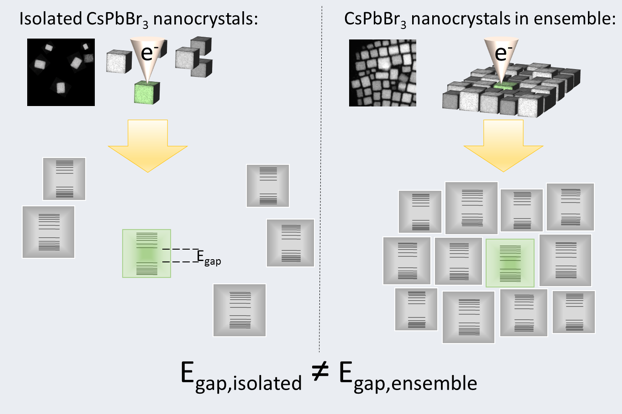Researchers determine relation bandgap energy of single cesium lead bromide nanocrystals

Researchers from the University of Amsterdam (UvA), in collaboration with Japanese partners, have determined the relation between the bandgap energy of single cesium lead bromide nanocrystals (CsPbBr3 NCs) and their size and shape. By studying individual NCs being either isolated or surrounded by 'neighbors', they explicitly visualized for the first time band structure modification introduced by effective coupling between semiconductor NCs upon close contact.
Nanocrystals and perovskites
NCs are extremely small, about a thousand times smaller than the width of a human hair. Due to their small size, the energy structure of the crystals is dramatically different from that of bulk material. In fact, the bandgap energy depends on the NC size.
The term 'perovskites' refers to the class of materials with a crystal structure in the form ABX3, and are named after the Russian mineralogist Lev Perovski. Recently, perovskites attract much attention due to their potential for high-efficient and low-cost photovoltaics. In CsPbBr3 NCs, the advantages of perovskites and NCs are combined, and they are therefore a promising material for various optoelectronic applications.
The experimental setup
The state-of-the-art technique the researchers employed, is called low-loss electron energy loss spectroscopy (EELS) and arises from low energy excitations i.e. valence electrons. It is therefore an analogy to absorption spectroscopy. Using EELS together with a scanning electron transmission (STEM) microscope with ultrahigh special resolution, allows the researchers to measure the NC dimensions and location with uniquely high precision, in parallel. In that way, the energy absorption is directly mapped onto individual NCs that are either embedded in an ensemble (they have neighbors) or are completely isolated. In that way, an intimate relation between the NC size, shape and energy bandgap is established.
Interaction and coupling between proximal nanocrystals
By determining the energy bandgap of many individual nanocrystals as a function of their size, the researchers have found that small isolated NCs appear to have a higher bandgap energy as compared to a NC of the same size surrounded by neighbors. And reversely, a large NC has lower bandgap energy if isolated than when embedded in an ensemble. Their result shows that two adjacent NCs do not simply 'merge' upon interaction and pose as a larger crystal, but rather 'average' their bandgaps. This provides direct evidence of an effective coupling between NCs where their energy bandgap and therefore energy structure, is influenced by the neighbors. These unique insights in the interacting behavior of neighboring NCs paves the way towards purposeful designing of large quantum structures and quantum-dot-solids, consisting of NCs with selective properties serving as building blocks.
More information: Junhao Lin et al. Direct Observation of Band Structure Modifications in Nanocrystals of CsPbBrPerovskite, Nano Letters (2016). DOI: 10.1021/acs.nanolett.6b03552
Journal information: Nano Letters
Provided by University of Amsterdam



















